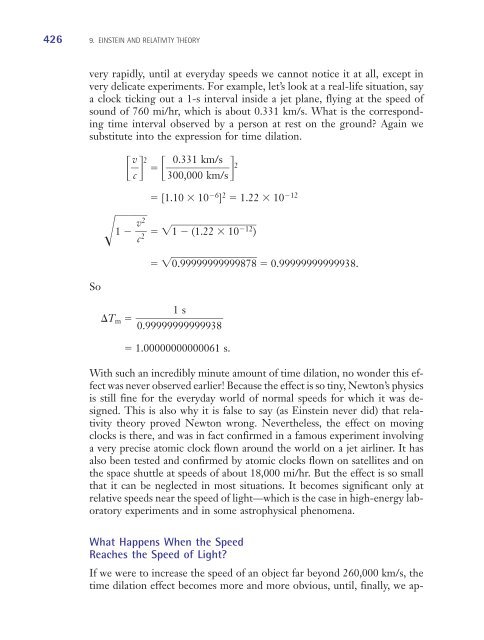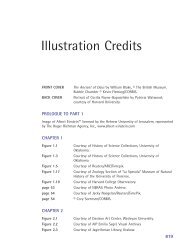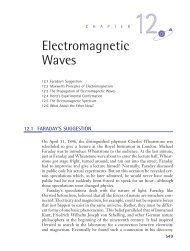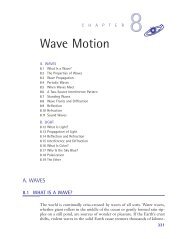Chapter 9: Einstein and Relativity Theory (319 KB) - D Cassidy Books
Chapter 9: Einstein and Relativity Theory (319 KB) - D Cassidy Books
Chapter 9: Einstein and Relativity Theory (319 KB) - D Cassidy Books
Create successful ePaper yourself
Turn your PDF publications into a flip-book with our unique Google optimized e-Paper software.
3637_<strong>Cassidy</strong>TX_09 6/14/02 12:08 PM Page 426<br />
426 9. EINSTEIN AND RELATIVITY THEORY<br />
very rapidly, until at everyday speeds we cannot notice it at all, except in<br />
very delicate experiments. For example, let’s look at a real-life situation, say<br />
a clock ticking out a 1-s interval inside a jet plane, flying at the speed of<br />
sound of 760 mi/hr, which is about 0.331 km/s. What is the corresponding<br />
time interval observed by a person at rest on the ground Again we<br />
substitute into the expression for time dilation.<br />
So<br />
v c 2 3<br />
0<br />
. 331<br />
km/s<br />
<br />
00,<br />
000<br />
km/s<br />
<br />
2<br />
[1.10 10 6 ] 2 1.22 10 12<br />
<br />
v<br />
1 1 (1<br />
2<br />
.22 1012 )<br />
c<br />
2<br />
T m <br />
0.9999 99999 99878 0.99999999999938.<br />
1 s<br />
<br />
0.99999999999938<br />
1.00000000000061 s.<br />
With such an incredibly minute amount of time dilation, no wonder this effect<br />
was never observed earlier! Because the effect is so tiny, Newton’s physics<br />
is still fine for the everyday world of normal speeds for which it was designed.<br />
This is also why it is false to say (as <strong>Einstein</strong> never did) that relativity<br />
theory proved Newton wrong. Nevertheless, the effect on moving<br />
clocks is there, <strong>and</strong> was in fact confirmed in a famous experiment involving<br />
a very precise atomic clock flown around the world on a jet airliner. It has<br />
also been tested <strong>and</strong> confirmed by atomic clocks flown on satellites <strong>and</strong> on<br />
the space shuttle at speeds of about 18,000 mi/hr. But the effect is so small<br />
that it can be neglected in most situations. It becomes significant only at<br />
relative speeds near the speed of light—which is the case in high-energy laboratory<br />
experiments <strong>and</strong> in some astrophysical phenomena.<br />
What Happens When the Speed<br />
Reaches the Speed of Light<br />
If we were to increase the speed of an object far beyond 260,000 km/s, the<br />
time dilation effect becomes more <strong>and</strong> more obvious, until, finally, we ap-






